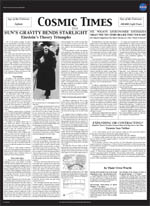1919 Articles

This poster is the first edition of the Cosmic Times, with the publication date chosen to coincide with the announcement of the first test of Einstein's General Theory of Relativity. Einstein published the theory in 1915, but the first test supporting General Relativity was announced in 1919. In fact, it was this test of General Relativity that really propelled Einstein to "rock star" status.
Jump to:
Content Overview :: Downloads :: Articles :: Lessons :: Style Notes
Content Overview
As the first edition of the Cosmic Times, several concepts are introduced, which will be revisited and built upon in future editions. The first concept, of course, is the idea of Einstein's General Relativity and its first confirmation. In addition, the idea of the size of the universe is indroduced. In 1919, the universe was viewed to contain only the stars in the Milky Way. Other galaxies had not yet been resolved into their constituent stars, so it was not apparent that some of the fuzzy nebula were, indeed, outside our own galaxy. The universe was a much smaller place than it is today, but change was just on the horizon.
Downloads
- 1919 Poster (printable at 8.5" x 11" or at its full size of 24" x 33"): pdf
- 1919 Newsletters:
- 1919 Questions for Understanding: doc, pdf
- 1919 Glossary: doc, pdf
- Full Cosmic Times Glossary: doc, pdf
Articles
- Age of the universe: Infinite; Size of the universe: 300,000 Light Years
Learn more about the age and size → - Sun's Gravity Bends Starlight
- Summary: Observations of stars near the Sun during the eclipse of 1919 show that the starlight bends just as predicted by General Relativity.
- Thread: Expanding Universe
- Additional background and information →
- Sidebar: Why a Total Eclipse?
- Summary: Describes why observers needed a solar eclipse to make observations of starlight bending around the Sun.
- Additional background and information →
- Mount Wilson Astronomer Estimates Milky Way Ten Times Bigger Than Thought
- Summary: Astronomer Harlow Shapely finds that the Milky Way is 10 times bigger than previous measurements, using the period-luminosity relationship for Cepheid variables as discovered by Henrietta Leavitt.
- Thread: Size of the Universe
- Additional background and information →
- Expanding or Contracting?
- Summary: Einstein's theory of General Relativity predicts that the Universe cannot be static – it must be expanding or contracting. Einstein adds the "Cosmological Constant" to keep the Universe static.
- Thread: Expanding Universe
- Additional background and information →
- In Their Own Words
- Summary: Snippets of papers published by other astronomers during this time. The snippets highlight the Cepheid period-luminosity relationship, redshift of galaxies, and the nature of spiral nebulae.
- Additional background and information →
Lesson Plans
Download a .zip file containing all 1919 lessons with their associated handouts: doc, pdf
Note: the pdf handouts for the "Discovering the Milky Way" and "Unsung Heroes" lessons are included in the .doc zip bundle.
- Einstein and His Times
- Overview: Students look at other 1919 events to decide if Einstein should be elected "Man of the Year"
- Grades: middle school and high school
- Topics: multidisciplinary
- Downloads
- Eclipses and Moon Phases
- Two Versions of Gravity: Newton and Einstein
- Einstein's Gravity
Style Notes
The language in the 1919 newspaper mimics the style of writing that would have appeared in a real 1919 newspaper. The language may be a bit difficult for your students to read; however, we have provided three versions of the text in newletter form: an Early Edition aimed at 7-8 graders, a Home Edition aimed at 9-10 grades (with text from the online edition), and a Late Edition aimed at 11-12 grades (with the text from the poster). These, along with a glossary and questions for understanding are available on the download page.
The poster also shows a layout that mimics the papers of the time, however, we have taken some creative license to make it more readable in a classroom setting. Real newspapers of the time would have had 5-7 narrow columns. The size of the text in each column would have gotten smaller and smaller as you read down the column, so the more details you wanted, the harder you would have had to work to read it.



